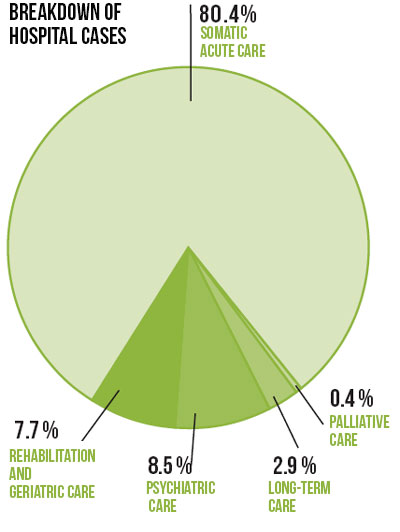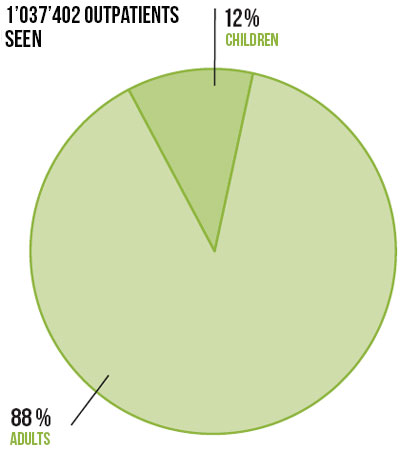
200’000
This is the number of people cared for in 2016
If we consider the 60,000 hospitalisations and the one million outpatients treated, this represents 200,000 people – the vast majority of whom come from Geneva – who, in the space of a year, had one or more contacts with HUG for treatment.
Rise in inpatient activity
In 2016, HUG handled 59,955 hospital stays compared to 59,430 in 2015. This steady rise since 2014 is primarily linked to the increase in and ageing of the population of the canton of Geneva.
NB: as the Joli-Mont and Montana Clinics were affiliated to HUG on 1 July, the HUG data is presented without these two clinics to make it easier to compare with previous years.
Rise in acute care
The change in activity differs according to the healthcare area. It has sharply increased in acute care. This has encouraged HUG to create acute care beds in palliative medicine at the Bellerive Hospital and increase the existing number of beds at the Trois-Chêne Hospital. In winter, additional beds were opened to cope with peaks of activity linked to influenza.
In psychiatry, the number of cases has dropped, but the length of stay has risen in the light of difficulties in placing patients in specialist institutions. The opening of an additional medium-stay unit, which took place in November 2016 thanks to the reorganisation of adult psychiatry, should facilitate the key role of the admission units for short-term treatments. In neurology and neurosurgery, continuous care was merged to meet the rise in demand.
38%
This is the rise, between 2012 and 2016, in the number of cases treated at HUG that fall under highly specialized and academic medicine. This activity represents 3.4% of cases and 10.7% of the sums billed. It demonstrates HUG’s regional appeal and influence.
Rise in outpatient activity
HUG encourages the development of alternatives to hospitalisation, for example one day surgery. There has been a steady rise in outpatient activity over the past few years: 35.9% since 2012.
In 2016, the threshold of one million patients seen was crossed, with a total of 1,037,402 cases. This corresponds to a 4.6% rise, linked in particular to the migrant crisis and the precariousness of certain people.
The activity is also growing in several departments:
- in neuro-reeducation with the creation of a day hospital
- in gynaecology-obstetrics with the development of medically assisted procreation (MAP)
- in ophthalmology thanks to the strengthening of the medical team and modernisation of the equipment
- in paediatrics following the reorganisation of outpatient consultations
- in maxillo-facial surgery with the opening of two additional dental medicine units
- in oncology with the use of stereotaxy
- in penitentiary medicine in connection with the increase in the number of inmates in La Brenaz prison
- in cardiology with the development of the heart failure programme
- in tropical medicine in connection with the emergence of the Zika virus and the increase in cases of malaria.
97%
of patients consider that they received “good” or “excellent” care
Activity at Joli-mont and Montana
The Joli-Mont Clinic specialises in treatment follow-up. In 2016, its activity increased: 1,344 admissions, 30,032 hospitalisation days and 84% occupancy rate. The average age of the patients is also increasing: 79 years in 2016 compared to 77 years in 2010.
The Montana Clinic cares for people suffering from chronic diseases or requiring psychotherapeutic care. In 2016, the number of admissions increased by 4.2% compared to 2015, i.e. 1,180 people admitted. The average length of stay decreased slightly, dropping from 18.2 to 17.5 days.
2,5 weeks
Among the indicators featuring in the service contract, the time between the first consultation and the operation is an important criterion in quality of care. At the breast centre, this period was 2.5 weeks in 2016 compared to 4.4 in 2011.